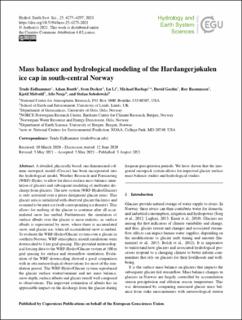| dc.contributor.author | Eidhammer, Trude | |
| dc.contributor.author | Booth, Adam | |
| dc.contributor.author | Decker, Sven | |
| dc.contributor.author | Li, Lu | |
| dc.contributor.author | Barlage, Mike | |
| dc.contributor.author | Gochis, Dave | |
| dc.contributor.author | Rasmussen, Roy | |
| dc.contributor.author | Melvold, Kjetil | |
| dc.contributor.author | Nesje, Atle | |
| dc.contributor.author | Sobolowski, Stefan | |
| dc.date.accessioned | 2022-03-10T13:47:14Z | |
| dc.date.available | 2022-03-10T13:47:14Z | |
| dc.date.created | 2021-01-12T10:13:41Z | |
| dc.date.issued | 2021 | |
| dc.identifier.issn | 1027-5606 | |
| dc.identifier.uri | https://hdl.handle.net/11250/2984329 | |
| dc.description.abstract | A detailed, physically based, one dimensional column snowpack model (Crocus) has been incorporated into the hydrological model, Weather Research and Forecasting (WRF)-Hydro, to allow for direct surface mass balance simulation of glaciers and subsequent modeling of meltwater discharge from glaciers. The new system (WRF-Hydro/Glacier) is only activated over a priori designated glacier areas. This glacier area is initialized with observed glacier thickness and assumed to be pure ice (with corresponding ice density). This allows for melting of the glacier to continue after all accumulated snow has melted. Furthermore, the simulation of surface albedo over the glacier is more realistic, as surface albedo is represented by snow, where there is accumulated snow, and glacier ice, when all accumulated snow is melted. To evaluate the WRF-Hydro/Glacier system over a glacier in southern Norway, WRF atmospheric model simulations were downscaled to 1 km grid spacing. This provided meteorological forcing data to the WRF-Hydro/Glacier system at 100 m grid spacing for surface and streamflow simulation. Evaluation of the WRF downscaling showed a good comparison with in situ meteorological observations for most of the simulation period. The WRF-Hydro/Glacier system reproduced the glacier surface winter/summer and net mass balance, snow depth, surface albedo and glacier runoff well compared to observations. The improved estimation of albedo has an appreciable impact on the discharge from the glacier during frequent precipitation periods. We have shown that the integrated snowpack system allows for improved glacier surface mass balance studies and hydrological studies. | en_US |
| dc.language.iso | eng | en_US |
| dc.publisher | Copernicus Publications | en_US |
| dc.rights | Navngivelse 4.0 Internasjonal | * |
| dc.rights.uri | http://creativecommons.org/licenses/by/4.0/deed.no | * |
| dc.title | Mass balance and hydrological modeling of the Hardangerjøkulen ice cap in south-central Norway | en_US |
| dc.type | Journal article | en_US |
| dc.type | Peer reviewed | en_US |
| dc.description.version | publishedVersion | en_US |
| dc.rights.holder | Copyright Author(s) 2021 | en_US |
| cristin.ispublished | true | |
| cristin.fulltext | original | |
| cristin.qualitycode | 2 | |
| dc.identifier.doi | 10.5194/hess-25-4275-2021 | |
| dc.identifier.cristin | 1869627 | |
| dc.source.journal | Hydrology and Earth System Sciences | en_US |
| dc.source.pagenumber | 4275-4297 | en_US |
| dc.relation.project | Notur/NorStore: NN9280K | en_US |
| dc.relation.project | Notur/NorStore: NS9001K | en_US |
| dc.identifier.citation | Hydrology and Earth System Sciences. 2021, 25 (8), 4275-4297. | en_US |
| dc.source.volume | 25 | en_US |
| dc.source.issue | 8 | en_US |

